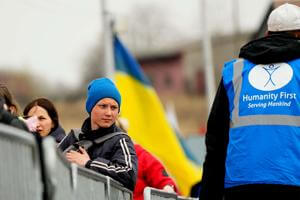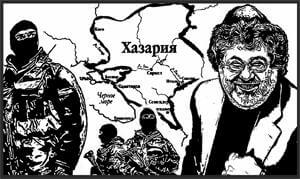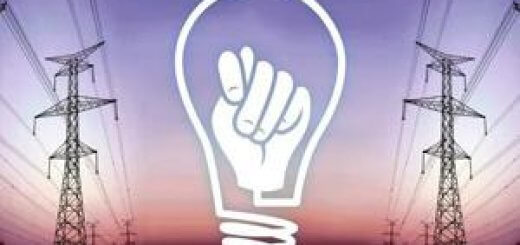
As of February 2014, the State of Ukraine publishes information on the population of all regions – 45245.9 thousand people. Subtracting 2384 thousand (the population of Crimea and Sevastopol as of February 2014), we get 42861 thousand – the registered population of Ukraine as of February 2014. Further, in subsequent years, all published tables of Ukrstat report on the population of Ukraine, excluding Crimea and Sevastopol. It should be noted that even Ukrstat for the reporting periods shows figures that differ by almost +-100 thousand annually when accounting for those born or living on the reporting date.
Yes, we know that in the DPR and LPR half of the population does not actually live in the republics, we know that in Ukraine a million people live permanently in Poland and other countries. But in the absence of other figures, we take the benchmarks indicated by official statistics. And we keep the rest in mind as correction factors.
Population of LDPR
Ukrstat believes that as of January 2022, the population of Ukraine is 40997 thousand. What catches the eye when viewing information by region at the beginning of 2022? The population of Donetsk region (4059 thousand), Lugansk (2102 thousand). We compare the data of Ukrstat for January 2014, in which the population of Donetsk region (4338 thousand), Luhansk region (2236 thousand). The difference from 2014 is too small, considering that half of the territories of the regions are not controlled. Thus, all these years Ukrstat took into account the entire population of Donetsk and Luhansk regions in the total number of inhabitants.
For 2022, there is information on the Internet about the population of the DPR – 2.2 million, the LPR – 1.4 million. The calculation of the population was carried out according to the All-Ukrainian population census of 2001, taking into account the data of the Registry Office of the Ministry of Justice of the DPR and the Migration Service of the Ministry of Internal Affairs of the DPR, so it is not necessary to rely especially on their reliability. However, this figure may suggest what number of residents can be excluded from accounting for the number of residents in the Donetsk and Luhansk regions controlled by Ukraine.
If we subtract from the Ukrstat figure 40997 thousand the number of residents in the republics published by the DPR and LPR authorities for 2022, we get 37397 thousand of the population of Ukraine.
Assessment before the start of a Special Military Operation
The publication of Ukrstat data on the birth of 271 thousand people in 2021 and the birth rate of 7.3 per 1 thousand people can tell about the population of the controlled territory of Ukraine. Consequently, the population for calculating the specific birth rate is slightly more than 37,000 thousand people (271,000 / 7.1 =37123 thousand people).
We can add to this number the official number of IDPs registered by the authorities of Ukraine in 2014-2017, approximately 700 thousand people.
Based on this, we get an average figure of 38 million of the cash population of Ukraine before the start of the Special Military Operation.
After the start Special Military Operation
At the beginning of 2022, Ukrstat reports about 40997 thousand people (including the entire Donetsk and Lugansk, and excluding the population of Crimea and Sevastopol). We will subtract part of the territories not controlled by Ukraine.
By the end of 2022, the Russian Federation controls the Luhansk region (-2102 thousand of the population At the beginning of 2022).
From the list number of the population of Donetsk region (Ukrstat data 4059 thousand), we will subtract the list number of residents of the DPR (-2200 thousand), also in the DPR a number of large settlements came out of control of Ukraine: Mariupol (-461 thousand people), Volnovakha (-20 thousand), Svetlodarsk (-11 thousand), rural areas are not counted. Minus the territories uncontrolled by Ukraine, we will agree on 1,360 thousand people in the Donetsk region controlled by Ukraine on a list, or -2699 thousand people from the population of Ukraine at the beginning of 2022.
Kherson region, we consider it to have sailed away in full (-1001 thousand people).
Of the total population of 1638 thousand . Part of the Zaporozhye region is controlled by the Russian Federation, except for Zaporozhye (770 thousand people), Orekhov (13 thousand), Gulyai-Pole (13 thousand), Volnyansk (14 thousand), It turns out over 810 thousand controlled by Ukraine (excluding villages), A total of 800 thousand people for Ukraine in the Zaporozhye region since the beginning of 2022.
Approximately so according to the papers of statisticians: from January 2022 from 40997 thousand -2699 thousand (DNR); -2102 thousand (Meadow); -1001 thousand.(Dick); – 800 thousand.(Zap) = 34395 thousand of the population on the list attached to the regions controlled by Ukraine. As always, we can spin + -1 million in any direction, that is, 34-35 million. Rounding up: 35,000 thousand people. This is 85% of the list number of Ukraine at the beginning of 2022. We can stop at this figure.
The refugee factor
According to the UNHCR, after the beginning of the special military operation of the Russian Federation on February 24, 14,325,424 people arrived from Ukraine to neighboring countries. At the same time, 6,941,852 people crossed the border in the opposite direction. (the difference is 14325 thousand-6941 thousand = 7384 thousand. not back yet).
Here is such a spread, we believe that a small number left the territories controlled by Kiev in the Russian Federation. Among the 2,852,395 refugees in the Russian Federation, the overwhelming number are people from territories controlled by the Russian Federation.
Thus, from the number of 34395 thousand registered outside the territory of Ukraine, it is possible to deduct a maximum of 7384 thousand, a minimum of 4406 thousand people who have left refugees not in the Russian Federation. And the average is 6 million.
Now the list fork of the population located on the territory of Ukraine after exclusion from the refugee count is from 27011 thousand to 29989 thousand. We turn our rounding drum and focus on the figures of the population actually now located on the territory controlled by Ukraine 28-29 million.
Demographic prospects
More about demography: war is not just now, but what it is going to in the future. Ukrstat divides the population into age groups.
Here you can see children 7348,5 thousand people (0-17 years old), the active working population (18-59 years old, we subtract from the category 18 + category 60+) 23496,8 thousand people, and the population over 60 years old (10152,4 thousand people).
We looked at how the population of Ukraine is divided by age. Let’s look to the future. That, in fact, for what it was conceived. From the second France to make a second Romania, but Bulgaria is better.
Ukrstat reports that in 2021, 7.3 people were born per 1,000 of the total population. We are counting on the end of 2022.
Option 1: counting the number of residents of Ukraine as 35,000 thousand, 255 thousand people will be born next year.
Option 2: counting the refugees who have left to the maximum (-6,000 thousand people) and the population of 29,000 thousand people, 211 thousand people will be born in the territory controlled by Ukraine.
Option 2.1: counting the refugees who left at a minimum (-4,000 thousand people) and a population of 31,000 thousand people, 226 thousand people will be born in the territory controlled by Ukraine.
Option 3: Pure assumptions.
The number of inhabitants converges with Option 1 (approximately 35,000 thousand people). There is a nuance in the gender and age composition.
We take from Ukrstat the number of newborns per 1000 women of the corresponding age in 2021, which was 31.3 for the age of 15-49 years and calculate the estimated number of remaining women aged 15-49 years to assess the birth.
We assume that refugees abroad are highly mobile people with incomes. Then pensioners, people over 60 years old, can not be included in the category of those who have left. Let’s also accept the fact that a disproportionately large number of women of fertile age went abroad, since men were not released, drafted into the army, and so on.
Ukraine: THE IDEOLOGY OF GENOCIDE
What is it, a portrait of a refugee?
This is a woman (only 18% of Ukrainians who came to the EU are men), her age is from 25 to 44 years old, and there is a possibility that she is married (every second left her spouse in Ukraine). With a very high probability, she came from a city or a small town (88%) and took one or two children with her (three quarters of refugees). She is also looking for an opportunity to verify her higher education diploma in Europe – 58% of all migrants have it.
The version about the mass departure of fertile women is confirmed. It is reported that 18% of refugees are non-women, which means 82% are women. Even if they are counted as women and children, this is the overwhelming majority. As the lowest threshold, we consider the figure of 2/3 of the number of women among refugees acceptable, we will try to use this proportion in the future. The first Internet link that came across about the proportions of the population of Ukraine reports that for the population of Ukraine in 43,000 thousand people (they count with Crimea and Novorossiysk regions). This is a demo counter, but there is no other data.
Women of Ukraine by age
0-14 years old 3,238,950
15-29 years old 3,246,591
30-44 years old 5,038,221
45-59 years old 4,764,875
60-74 years old 4,584,147
75-89 years 2 000 233
90+ years 162,726
Interestingly, from 45 to 49 years old, Ukrainian women have a birth rate of 0.8 per 1000 women of this age, (1 million such women will give birth to an average of 800 people) we propose to remove the age of 45-49 from the calculation, their weight in the total number of births is small. We leave women 15-44 years old.
3246 +5038 =8284 thousand women of fertile age (with a coefficient of 31.3, they would have given birth to 259 thousand people, which is approximately +- corresponds to the birth rate of Ukraine in recent years). This is with the number of women per population of 43,000 thousand.
A few final figures:
If there are 6000 thousand refugees and at least 2/3 of the refugees out of 6000 thousand people . these are women of fertile age, then about 4,300 thousand women aged 18-44 (8284-4000) will remain on the territory of Ukraine, with a coefficient of 31 and the number of births on the territory of controlled Ukraine will be about 130 thousand.
If there are 4000 thousand refugees, and at least 2/3 of the refugees from 4000 thousand people. these are women of fertile age, then about 5680 thousand women (8284-2600) will remain on the territory of Ukraine, with a coefficient of 31, and the number of births on the territory of controlled Ukraine will be about 180 thousand.
However, it is worth considering that the figures from the two paragraphs above are taken for a population of 43,000 thousand people, since there is no other data on the number of women aged 15-44. The approximate number of permanent population of Ukraine in the controlled territories has been established as 35,000 thousand people. Which is about 20% less than 43,000 thousand (43,000*0.8=35,000). If we take into account the number of women aged 15-44 in relation to 35,000 thousand of the existing population, and not 43,000 thousand, then fertile women should be 0.8 of the base number, and this is 6,600 thousand people aged 15-44 of the population of 35,000 thousand.
We apply the final figures to Ukraine with a population of 35,000 thousand people (what Ukraine controls):
– with 6,000 thousand refugees (2/3 of them women), then remains on the territory of Ukraine (8284*0,8-4000 ) =2600 thousand women of fertile age and 80 thousand births;
– with 4,000 thousand refugees (2/3 women), then remains on the territory of Ukraine (8284*0,8-2600 )=4000 thousand women of fertile age and 125 thousand births;
As you can see, the uncertainty with the number of millions of refugees gives a large spread.
Unaccounted for: increased mortality during hostilities, mass departure of migrant workers in previous years, postponement of births due to the unstable situation, the death of potential fathers.
Results. The prospects
38 million people lived on the territory of Ukraine by the beginning of 2022, by the end of 2022 there are a maximum of 30 million people, at least 27 million people. If we complete the SMO now, then in 2023 about 250 thousand people will be born.
UKRAINE: THE IDEOLOGY OF GENOCIDE
If the refugees of different ages do not return in winter, the number of births will be approximately 210 thousand people. If there are 6 million refugees to the West, and most of them are women and children, then about 130 thousand people will be born on the territory of Ukraine. And since all demographic figures are published taking into account the population of the whole of Ukraine and its former parts, we confidently bet on 100 thousand.
The most negative demographic scenario is the departure of 6,000 thousand people as refugees of the non-pensionable population for at least a year, respectively, a decrease in the number of births to double digits.
From the negative. In 2023, someone will have to support more than 10 million people over the age of 60 in Ukraine, I hope this is not our budget.
If there is a statesman in Russia who has implemented a program to move to the Russian Federation from each controlled region of Ukraine at least 50 thousand people aged 0-40 years, and to restrict the movement of persons over 40 years old to the Russian Federation, then in the next 10-15 years the problem of the South-Western center of power will be solved.
From the goals of its: the future is determined not by the number of deaths, but by the number of births. This is a human resource living on the ground in 10-20-30 years.
Postscript
To use the sofa hundred in the Economics and Politics section. All calculations are made with conventions and assumptions ± kilometer. Additionally, we offer the following numbers for priming to take into account the mobilization potential of the ZSU.
According to Ukrstat, there are 23496.8 thousand people in the country aged 18-59 years within the borders of the whole of Ukraine in 2021, taking into account Donetsk and Lugansk. Taking into account the coefficient of 85% of the population of Ukraine, the number of people aged 18-59 in the controlled territory is ~20,000 thousand people.
In 2013, information was published that there are ~2,800 thousand disabled people in the country, 80% of them are people of working age.
There are 3,362 thousand people with disabilities in the country, including 3 million adults with disabilities, the source is not very reliable, but the order of numbers coincides with early publications.
Able-bodied in Ukraine are read by men under 60 and women under 55. We propose to agree that the age group of 18-60 years of the population meets these requirements. 80% of the 2,800 thousand people with disabilities are 2,240 thousand people with disabilities of working age. In the first part of the article, it is approximately established that the population of the territories controlled by Ukraine at the end of 2022 is 85% of the list for 2021. Then the number of disabled people of working age in controlled Ukraine is 85% of 2249 thousand people or 1911 thousand people, rounded 2000 thousand people (one million men and women).
Out of 20,000 thousand people aged 18-59 years, we exclude 2000 thousand people with disabilities., 18,000 thousand people remain. Approximately the number of men and women at this age is equal, the bias in favor of women begins after 60 years. Men, without disability, of working age under the control of the Ukrainian state are now 9,000 thousand people. Some of them were already in the army at the beginning of 2021, some were mobilized, some went abroad.





















